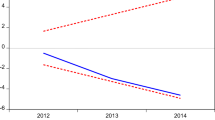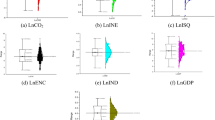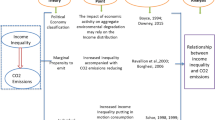Abstract
This study probes the environmental consequences of income inequality (INQ) in G7 economies from 1971 to 2015. INQ is captured by four indicators comprising GINI coefficients, Palma ratio, Theil index, and Atkinson index on per capita carbon emission as a proxy for environmental degradation using both fully modified OLS (FM-OLS) and dynamic OLS (D-OLS). The empirical data are subjected to pre-test using cross-sectional dependence (CSD) test and panel unit root and panel cointegration tests. The following results are established. First, the absence of CSD and presence of cointegration is confirmed. Second, positive effects of INQ indices are reported for the panel analyses. Third, the results of country-specific analyses are divergent and mixed among the G7 economies. For instance, positive impacts are reported for Canada, Japan, and the USA and negative for France and Germany; and insignificant impacts are evident in the case of Italy and the UK. Fourth, the effects of other covariates emerge from two directions entailing both positive and negative. While per capita GDP (LGDPPC) and trade openness (OPN) are aligned with the former a prior, per energy use (PEU) and inflation (INF) satisfied the latter. Consequently, embarking on pro-poor programs such as social welfare funds, private initiative support fund, and state intervention aimed at checkmating the excesses of the capitalists is seen as sacrosanct to solving the INQ-pco2 nexus disharmony.









Similar content being viewed by others
Data Availability
The datasets generated during and/or analyzed during the current study are available in World Bank Development Indicators (WDI): https://databank.worldbank.org/source/world-development-indicators.
Notes
Goal 10 of SDGs focuses on how to reduce inequality within and among countries, while goals 8, 11, 12, 13, 14, and 15 respectively are devoted to environment and other environmental related issues.
These countries are Canada, France, Germany, Italy, Japan, the UK, and the USA.
Is an acronym for Oxford Committee for Famine Relief
This is the not the focus of the study.
With the exception of the USA that has decided to withdraw from the Paris Agreement 2020. That said, the USA is still the largest economy and producer as well as consumer of fossil fuel.
This activity alone is the third largest source of greenhouse gas emissions, generating between 15 and 20% of overall carbon emissions (Wolde-Rufael and Idowu, 2016).
DOSL is a modification of the FMOLS model by supplementing the cointegrating regression with lead and lagged differences of the regressors. This enables correction for endogeneity and serial correlation parametrically (see Pedroni 2000) for mathematical details).
It should be noted that the model allows for deviation in the patterns of the deterministic term and also variation in the lag lengths for individual series. The conditions for each pi can be computed by adopting a general-to-specific approach based on current information with respect to either AIC or the SIC criterion or on successively evaluating the last coefficient of the Δgi, t − j.
References
Ajide K, Ridwan I (2018) Energy consumption, environmental contaminants, and economic growth: the G8 experience. Appl Econ 51:58–83
Ali HS, Zeqiraj V, Lin WL, Law SH, Yusop Z, Bare UAA, Chin L (2019) Does quality institutions promote environmental quality? Environ Sci Pollut Res 26(11):10446–10456
Azam M, Liu L, Ahmad N (2021) Impact of institutional quality on environment and energy consumption: evidence from developing world. Environment, Development and Sustainability: A Multidisciplinary Approach to the Theory and Practice of Sustainable Development 23(2):1646–1667
Baek J, Gweisah G (2013) Does income inequality harm the environment?: Empirical evidence from the United States. Energy Policy 62:1434–1437
Bernauer T, Koubi V (2009) Effects of political institutions on air quality. Ecol Econ 68(5):1355–1365
Berthe A, Elie L (2015) Mechanisms explaining the impact of economic inequality on environmental deterioration. Ecol Econ 116:191–200
Boyce JK (1994) Inequality as a cause of environmental degradation. Ecol Econ 11:169–178
Brännlund R, Ghalwash T (2008) The income–pollution relationship and the role of income distribution: an analysis of Swedish household data. Resour Energy Econ 30(3):369–387
Breitung J (2000) The local power of some unit root tests for panel data. In: Baltagi B (ed) Nonstationary Panels, Panel Cointegration, and Dynamic Panels, vol 15. Advances in Econometrics, pp 161–178
Choi I (2001) Unit root tests for panel data. J Int Money Financ 20:249–272
Coondoo D, Dinda S (2008) Carbon dioxide emission and income: a temporal analysis of cross-country distributional patterns. Resour Energy Econ 65(2):375–385
Cushing L, Morello-Frosch R, Wander M, Pastor M (2015) The haves, the have-nots, and the health of everyone: the relationship between social inequality and environmental quality. Annu Rev Public Health 36:193–209
Demir C, Cergibozan R, Gök A (2019) Income inequality and CO2 emissions: empirical evidence from Turkey. Energy & Environment 30(3):444–461
Eggoh JC, Bangaké C, Rault C (2011) Energy consumption and economic growth revisited in African countries. Energy Policy 39(11):7408–7421
Goel RK, Herrala R, Mazhar U (2013) Institutional quality and environmental pollution: MENA countries versus the rest of the world. Econ Syst 37(4):508–521
Golley J, Meng X (2012) Income inequality and carbon dioxide emissions: the case of Chinese urban households. Econ Syst 34(6):1864–1872
Grossman GM, Krueger AB (1995) Economic growth and the environment. Q J Econ 110(2):353–377
Grunewald N, Klasen S, Martínez-Zarzoso I, Muris C (2017) The trade-off between income inequality and carbon dioxide emissions. Econ Syst 142:249–256
Guo L (2013) Cross-country income disparity and its effect on carbon emissions. Chinese Journal of Population Resources and Environment 11(1):33–50
Hadri K (2000) Testing for stationarity in heterogeneous panel data. Econ J 3:148–161
Hao Y, Chen H, Zhang Q (2016) Will income inequality affect environmental quality? Analysis based on China’s provincial panel data. Ecol Indic 67:533–542
Hayden A, Shandra JM (2009) Hours of work and the ecological footprint of nations: an exploratory analysis. Local Environ 14(6):575–600
Heerink N, Mulatu A, Bulte E (2001) Income inequality and the environment: aggregation bias in environmental Kuznets curves. Ecol Econ 38(3):359–367
Hosseini HM, Kaneko S (2013) Can environmental quality spread through institutions? Energy Policy 56:312–321
Ibrahim RL, Ajide KB (2020) Trade facilitation, institutional quality, and sustainable environment: renewed evidence from Sub-Saharan African Countries. J Afr Bus:1–23
Ibrahim RL, Ajide KB (2021a) Nonrenewable and renewable energy consumption, trade openness, and environmental quality in G-7 countries: the conditional role of technological progress. Environ Sci Pollut Res:1–18
Ibrahim RL, Ajide KB (2021b) The role of income level and institutional quality in the non-renewable energy consumption and life expectancy nexus: evidence from selected oil-producing economies in Africa. OPEC Energy Review
Ibrahim RL, Ajide KB (2021c) Disaggregated environmental impacts of non-renewable energy and trade openness in selected G-20 countries: the conditioning role of technological innovation. Environ Sci Pollut Res Int:1–15
Ibrahim RL, Ajide KB (2021d) Trade facilitation and environmental quality: empirical evidence from some selected African countries. Environment, Development and Sustainability, pp 1–31
Ibrahim RL, Ajide KB, Omokanmi OJ (2021) Non-renewable energy consumption and quality of life: evidence from Sub-Saharan African economies. Res Policy 73:102176
Im KS, Pesaran MH, Shin Y (2003) Testing for unit roots in heterogeneous panels. J Econ 115(1):53–74
IPCC, Edenhofer O, Pichs-Madruga R, Sokona Y, Farahani E, Kadner S, Seyboth K, Adler A, Baum I, Brunner S, Eickemeier P, Kriemann B, Savolainen J, Schlömer S, von Stechow C, Zwickel T, Minx JC (2014) Climate change 2014: mitigation of climate change. Contribution of Working Group III to the Fifth Assessment Report of the Intergovernmental Panel on Climate Change. Cambridge University Press, Cambridge, United Kingdom and New York, NY, USA
Islam, S. N. (2015). Inequality and environmental sustainability.
Jorgenson A, Schor J, Huang X (2017) Income inequality and carbon emissions in the United States: a state-level analysis, 1997–2012. Ecol Econ 134:40–48
Kao C (1999) Spurious regression and residual-based tests for cointegration in panel data. Journal of Ecoometrics 90:1–44
Kashwan P (2017) Inequality, democracy, and the environment: a cross-national analysis. Ecol Econ 131:139–151
Kasuga H, Takaya M (2017) Does inequality affect environmental quality? Evidence from major Japanese cities. J Clean Prod 142:3689–3701
Khan Z, Malik MY, Latif K, Jiao Z (2020) Heterogeneous effect of eco-innovation and human capital on renewable & non-renewable energy consumption: disaggregate analysis for G-7 countries. Energy 209:118405
Kinda S (2011) Democratic institutions and environmental quality: effects and transmission channels. Available at SSRN 2714300
Knight KW, Schor JB, Jorgenson AK (2017) Wealth inequality and carbon emissions in high-income countries. Social Currents 4(5):403–412
Kusumawardani D, Dewi AK (2020) The effect of income inequality on carbon dioxide emissions: a case study of Indonesia. Heliyon 6(8):e04772
Levin A, Lin CF, Chu CSJ (2002) Unit root tests in panel data: asymptotic and finite-sample properties. J Econ 108:1–24
Maddala GS, Wu SA (1999) Comparative study of unit root tests with panel data and a new simple test. Oxf Bull Econ Stat 61:631–652
Magnani E (2000) The environmental Kuznets curve, environmental protection policy and income distribution. J Econ 32:431–443
Oxfam (2018). https://www.oxfam.org/en/research/commitment-reducing-inequality-index-2018. Accessed 18 Jan 2019
Oxfam (2019). https://www-cdn.oxfam.org/s3fs-public/file_attachments/cr-even-it-up-extreme-inequality-291014-en.pdf
Pedroni P (1996) Fully modified OLS for heterogeneous cointegrated panels and the case of purchasing power parity. Manuscript, Department of Economics, Indiana University 5:1–45
Pedroni P (2000) Fully modified OLS for heterogeneous cointegrated panels in advances in econometrics: Vol. 15. Nonstationary Panels, Panel Cointegration, and Dynamic Panels
Pesaran HM (2004) General diagnostic tests for cross-sectional dependence in panels. University of Cambridge, Cambridge Working Papers in Economics, 435
Ravallion M, Heil M, Jalan J (2000) Carbon emissions and income inequality. Oxf Econ Pap 52(4):651–669
Torras M, Boyce JK (1998) Income, inequality, and pollution: a reassessment of the environmental Kuznets curve. Ecol Econ 25(2):147–160
Veblen T (1934) Theory of the leisure class. Modern Library, New York
Wawrzyniak D, Doryń W (2020) Does the quality of institutions modify the economic growth-carbon dioxide emissions nexus? Evidence from a group of emerging and developing countries. Economic research-Ekonomska istraživanja 33(1):124–144
Wisman JD (2011) Inequality, social respectability, political power, and environmental devastation. Journal of Economic Issues 45(4):877–900
Wolde-Rufael Y, Idowu S (2017) Income distribution and CO2 emission: A comparative analysis for China and India. Renew Sust Energ Rev 74:1336–1345
World Bank, 2018. World Development Indicators databank.worldbank.org. Accessed 18 Jan 2019
Yameogo CE, Omojolaibi JA, Dauda RO (2020) Economic globalisation, institutions and environmental quality in sub-Saharan Africa. Research in Globalization:100035
Author information
Authors and Affiliations
Contributions
KBA writes the manuscript.
RLI writes the manuscript.
Corresponding author
Ethics declarations
Ethics approval and consent to participate
This article does not contain any studies with human participants performed by any of the authors.
Consent for publication
Not applicable
Competing interests
The authors declare no competing interests.
Additional information
Responsible Editor: Nicholas Apergis
Publisher’s note
Springer Nature remains neutral with regard to jurisdictional claims in published maps and institutional affiliations.
Appendix
Appendix
Rights and permissions
About this article
Cite this article
Ajide, .B., Ibrahim, .L. Environmental impacts of income inequality: evidence from G7 economies. Environ Sci Pollut Res 29, 1887–1908 (2022). https://doi.org/10.1007/s11356-021-15720-6
Received:
Accepted:
Published:
Issue Date:
DOI: https://doi.org/10.1007/s11356-021-15720-6




